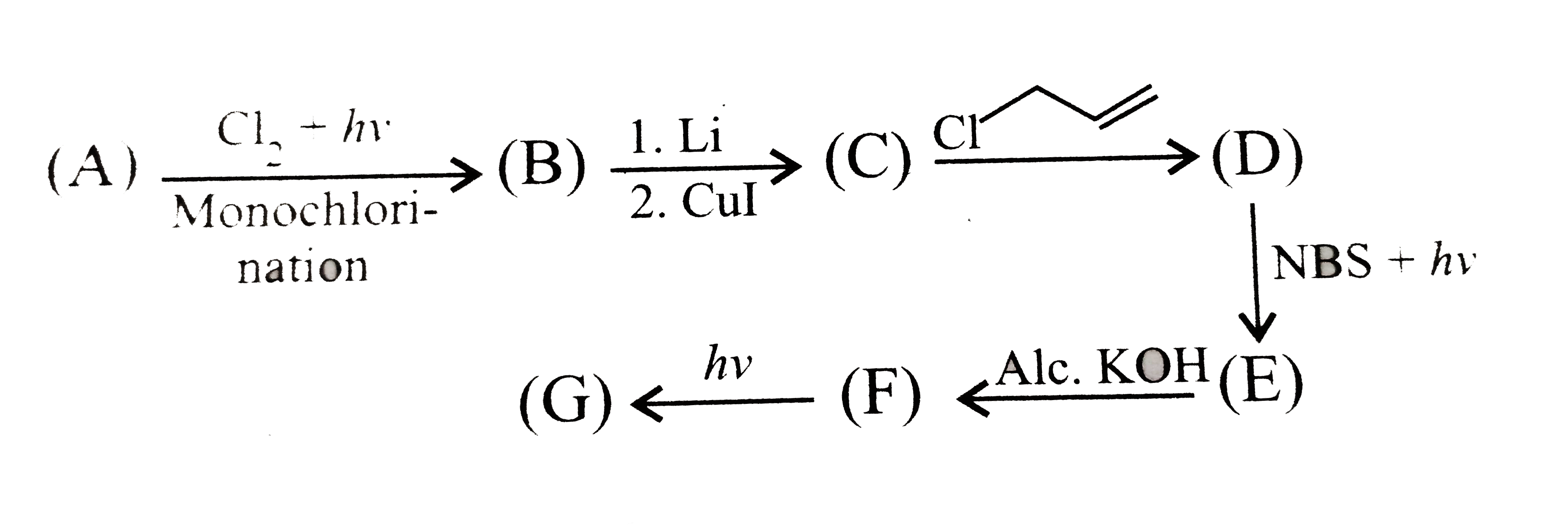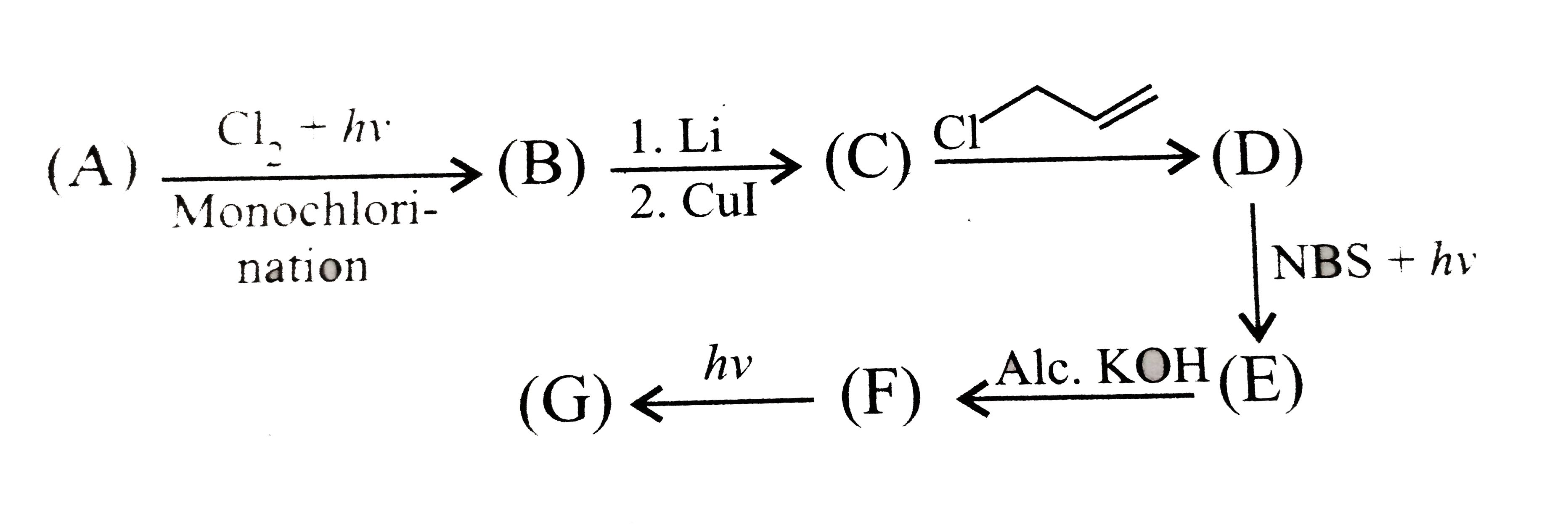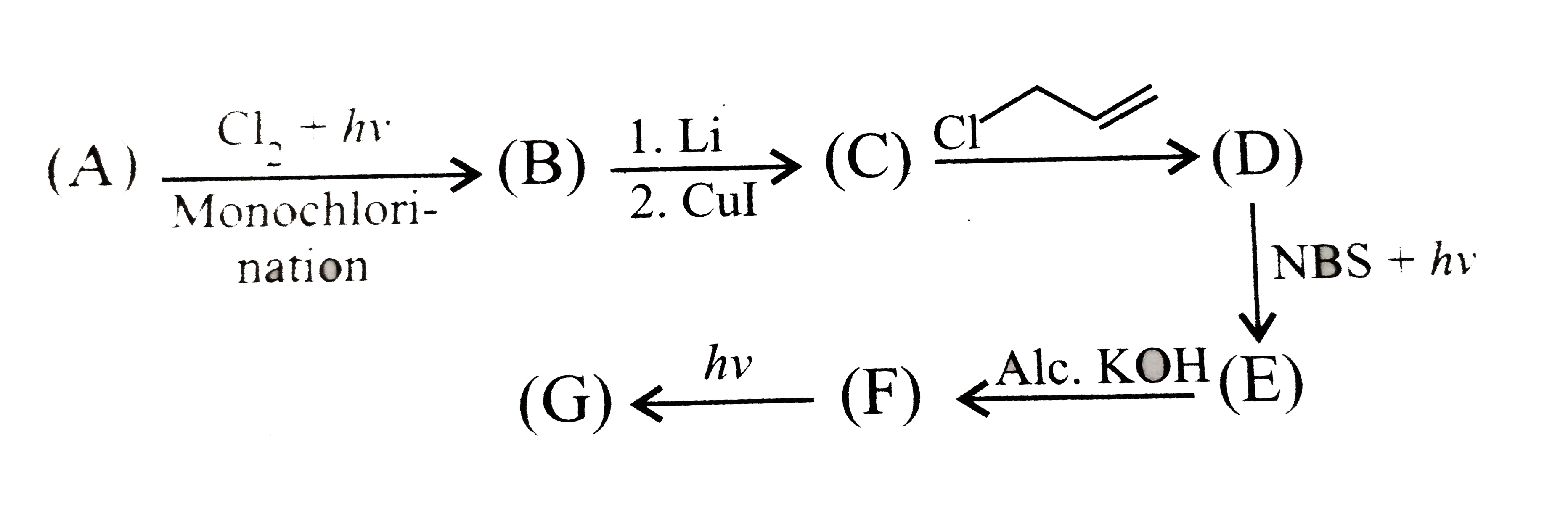10 " mL of " a gaseous organic compound containing C, H and O only,mixed with 100 " mL of " O2 and exploded under conditionwhich allowed the H2O formed to condense.Volume of the gas after explosion was 90 mL. On treatment with KOH solution,further contraction of 20 mL in volume was observed. The vapour density of the compound is 23. All volume measurements were made under the same condition.
Q.The molecular formula of the compound is
C3H8O
C3H6O
C2H6O
C2H4O
The correct Answer is:C
To find the molecular formula of the gaseous organic compound containing carbon (C), hydrogen (H), and oxygen (O), we will follow these steps:
Step 1: Identify the volumes given in the problem
- Volume of organic compound (V_compound) = 10 mL
- Volume of O2 = 100 mL
- Volume after explosion = 90 mL
- Volume after treatment with KOH = 70 mL (90 mL - 20 mL contraction)
Step 2: Determine the volume of CO2 produced
The contraction of 20 mL after treatment with KOH indicates that this volume is due to the absorption of CO2. Thus, the volume of CO2 produced is:
- Volume of CO2 = 20 mL
Step 3: Relate the volume of the organic compound to the volume of CO2 produced
From the stoichiometry of combustion, we know that:
- 10 mL of the organic compound produces 20 mL of CO2.
This implies that each molecule of the organic compound produces 2 molecules of CO2. Therefore, the organic compound must contain at least 2 carbon atoms.
Step 4: Calculate the mass of carbon in the compound
The molar volume of a gas at standard conditions is 24 L (or 24000 mL). Thus:
- 10 mL of the organic compound corresponds to 10/24000 moles.
- 20 mL of CO2 corresponds to 20/24000 moles.
Since 1 mole of CO2 contains 1 mole of carbon, the number of moles of carbon produced is:
- Moles of C = 20/24000 = 1/1200 moles.
Since each molecule of the organic compound produces 2 moles of CO2, the moles of the organic compound is:
- Moles of organic compound = (1/1200) / 2 = 1/2400 moles.
Step 5: Calculate the vapor density and molecular mass
The vapor density (VD) is given as 23. The molecular mass (M) can be calculated using the formula:
- M = 2 × VD = 2 × 23 = 46 g/mol.
Step 6: Determine the mass of carbon in the compound
Since we have established that there are 2 carbon atoms in the compound:
- Mass of carbon = 2 × 12 = 24 g/mol.
Step 7: Calculate the remaining mass for hydrogen and oxygen
The remaining mass for hydrogen and oxygen is:
- Remaining mass = Molecular mass - Mass of carbon = 46 - 24 = 22 g/mol.
Step 8: Determine the number of hydrogen and oxygen atoms
Assuming there is 1 oxygen atom (mass = 16 g/mol), we can calculate the mass of hydrogen:
- Mass of hydrogen = Remaining mass - Mass of oxygen = 22 - 16 = 6 g/mol.
Since the mass of one hydrogen atom is 1 g/mol, the number of hydrogen atoms is:
- Number of hydrogen atoms = 6.
Step 9: Write the molecular formula
Thus, the molecular formula of the compound is:
- C2H6O.
Final Answer:
The molecular formula of the compound is C2H6O.
---
- Volume of organic compound (V_compound) = 10 mL
- Volume of O2 = 100 mL
- Volume after explosion = 90 mL
- Volume after treatment with KOH = 70 mL (90 mL - 20 mL contraction)
The contraction of 20 mL after treatment with KOH indicates that this volume is due to the absorption of CO2. Thus, the volume of CO2 produced is:
- Volume of CO2 = 20 mL
From the stoichiometry of combustion, we know that:
- 10 mL of the organic compound produces 20 mL of CO2.
This implies that each molecule of the organic compound produces 2 molecules of CO2. Therefore, the organic compound must contain at least 2 carbon atoms.
The molar volume of a gas at standard conditions is 24 L (or 24000 mL). Thus:
- 10 mL of the organic compound corresponds to 10/24000 moles.
- 20 mL of CO2 corresponds to 20/24000 moles.
- Moles of C = 20/24000 = 1/1200 moles.
- Moles of organic compound = (1/1200) / 2 = 1/2400 moles.
The vapor density (VD) is given as 23. The molecular mass (M) can be calculated using the formula:
- M = 2 × VD = 2 × 23 = 46 g/mol.
Since we have established that there are 2 carbon atoms in the compound:
- Mass of carbon = 2 × 12 = 24 g/mol.
The remaining mass for hydrogen and oxygen is:
- Remaining mass = Molecular mass - Mass of carbon = 46 - 24 = 22 g/mol.
Assuming there is 1 oxygen atom (mass = 16 g/mol), we can calculate the mass of hydrogen:
- Mass of hydrogen = Remaining mass - Mass of oxygen = 22 - 16 = 6 g/mol.
Since the mass of one hydrogen atom is 1 g/mol, the number of hydrogen atoms is:
- Number of hydrogen atoms = 6.
Thus, the molecular formula of the compound is:
- C2H6O.
The molecular formula of the compound is C2H6O.
Topper's Solved these Questions
- STOICHIOMETRYBOOK - CENGAGE CHEMISTRY ENGLISHCHAPTER - STOICHIOMETRYEXERCISE - Exercises Multiple Correct
30 Videos
- STOICHIOMETRYBOOK - CENGAGE CHEMISTRY ENGLISHCHAPTER - STOICHIOMETRYEXERCISE - Exercises Single Correct
85 Videos
- STOICHIOMETRYBOOK - CENGAGE CHEMISTRY ENGLISHCHAPTER - STOICHIOMETRYEXERCISE - Exercises Subjective
31 Videos
- STATES OF MATTERBOOK - CENGAGE CHEMISTRY ENGLISHCHAPTER - STATES OF MATTEREXERCISE - Exercises (Ture False)
25 Videos
- THERMODYNAMICSBOOK - CENGAGE CHEMISTRY ENGLISHCHAPTER - THERMODYNAMICSEXERCISE - Archives (Subjective)
23 Videos
Similar Questions
10 mL of a gaseous organic compound containing C,H and O only was mixed with 100 mL of O2 and exploded under condition which allowed the H2O formed to condense. The volume of the gas after explosion was 90 mL. On treatment with KOH solution, a further contraction of 20 mL in volume was observed. The vapour density of the compound is 23. All volume measurements were made under the same condition.
The molecular formula of the compound is
View Solution10 " mL of " a gaseous organic compound containing C, H and O only was mixed with 100 " mL of " O2 and exploded under condition which allowed the H2O formed to condense. The volume of the gas after explosion was 90 mL. On treatment with KOH solution, a further contraction of 20 mL in volume was observed. The vapour density of the compound is 23. All volume measurements were made under the same condition.
Q.The volume of unreacted O2 is
View Solution10 " mL of " a gaseous organic compound containing C, H and O only was mixed with 100 " mL of " O2 and exploded under condition which allowed the H2O formed to condense. The volume of the gas after explosion was 90 mL. On treatment with KOH solution, a further contraction of 20 mL in volume was observed. The vapour density of the compound is 23. All volume measurements were made under the same condition.
Q.The volume of CO2 is
View Solution16 " mL of " a gaseous compound CnH3nOm was mixed with 60 " mL of " O2 and sparked. The gas mixture on cooling occupied 44 mL. After treatment with NaOH solution, the volume of gas remaining was 12 mL. Deduce the formula of the compound.
View SolutionA definite amount of gaseous hydrocarbon having (carbon atoms less than5) was burnt with sufficient amount of O2. The volume of all reactants was 600mL. After the explosion the volume of the product [CO2(g) and H2O(g)] was found to be 700mL under the similar conditions. The molecular formula of the compound is ?
View Solution10ml of compound containing 'N' and 'O' is mixed with 30ml of H2 to produce H2O(l) and 10ml of N2(g). Molecular formula of compound if both reactants completely, is
View SolutionA 20 mL mixture of ethane, ethylene, and CO2 is heated with O2. After explosion, there was a contraction of 28 mL and after treatment with KOH, there was a further contraction of 30 mL. What is the composition of the mixture?
View SolutionTwenty millilitres of a gaseous hydrocarbon (A) was exploded with excess of oxygen in eudiometer tube. On cooling, the volume was reduced by 50ml. On further treatement with KOH solution, there was a further contraction of 40 ml.

Compound (C) is:
View SolutionTwenty millilitres of a gaseous hydrocarbon (A) was exploded with excess of oxygen in eudiometer tube. On cooling, the volume was reduced by 50ml. On further treatement with KOH solution, there was a further contraction of 40 ml.

Compound (G) is:
View SolutionTwenty millilitres of a gaseous hydrocarbon (A) was exploded with excess of oxygen in eudiometer tube. On cooling, the volume was reduced by 50ml. On further treatement with KOH solution, there was a further contraction of 40 ml.

Compound (D) is:
View Solution
